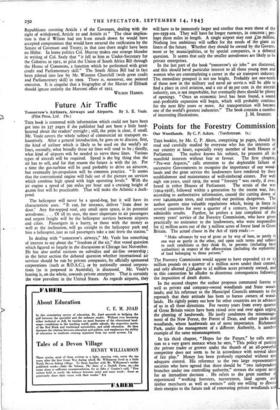Future Air Traffic
THIS book is crammed with information which could not have been got into its 337 pages if the publisher had not been a little hard- hearted about the readers' eyesight ; still, the print is clear, if small. Mr. Veale covers the whole subject of commercial air transport ex- haustively. After a general introduction, he goes on to discuss, first, the kind of airliner which is likely to be used on the world's air lines, secondly, what broadly those air lines will tend to be ; thirdly, what kind of airports will be needed to serve those lines. Various types of aircraft will be required. Speed is the big thing that the air has to sell, and for that reason the future is with the jet. For a time the gas-turbine will be used probably to drive an airscrew, but eventually jet-propulsion will be common practice. "It seems that the conventional engine will fade out of the picture on services which combine high speed with high operating levels." With the jet engine a speed of 500 miles per hour and a cruising height of 40p00 feet will be practicable. That will make the Atlantic a duck- pond.
The helicopter will never be a speed-hog, but it will have its characteristic uses.. "It can, for instance, deliver 'from door to door.' Any flat-topped roof, any small open space, is its potential aerodrome. . . Of all its uses, the most important to air passengers and urgent freight will be the helicopter services between airports and cities. Passengers in a hurry, or those with the money as well as the inclination, will go straight to the helicopter park and hire a helicopter, just as rail passengers take a taxi fro-n the station."
In dealing with "tomorrow's airways," Mr. Veale has something of interest to say about the "freedom of the air," that vexed question which figured so largely in the discussions at Chicago last November. He has also useful sections on subsidies and air-line ownership ; in the latter section the debated question whether international air services should be run by private companies, by officially sponsored corporations (such as B.O.A.C.), or by nationally owned corpora- tions (as is proposed in Australia), is discussed. Mr. Veale's leaning is, on the whole, towards private enterprise. That is certainly the view prevalent in the United States. As regards airports, they will have to be immensely larger and costlier than were those of the pre-I939 era. They will have far longer runways, in concrete ; per- haps three miles in length. A single airport may cost Lao million. Nothing less ambitious will suffice for the needs of the giant air liners of the future. Whether they should be owned by the Govern- ment or by municipalities, or by special companies, is a debated question. It seems that only the smaller aerodromes are likely to be private enterprises.
In the last part of the book "tomorrow's air jobs" are discussed, and this should beat' particular interest to all those young men and women who are contemplating a career in the air transport industry. The immediate prospect is not too bright. Probably not one-tenth of those now in the military and naval air services will be able to find a place in civil aviation, and a cut of 90 per cent. in the aircraft industry, too, is not improbable, but eventually there should be plenty of openings. "Once an economic level has been found, a sound and- profitable expansion will begin, which will probably continue for the next fifty years or more. Air transportation will become one of the world's greatest industries." The book contains a number


























 Previous page
Previous page